
Background information
iPhone 16e in everyday life: five big differences to the iPhone 16
by Florian Bodoky
Robust. Resistant. Scratch-resistant. Actually indestructible. An iPhone 11 can withstand 15 drops in a row thanks to Gorilla Glass 6. Really?
Corning promises a lot. "Tougher and more durable" than anything else is the new Gorilla Glass 6 on the iPhone 11. 15 drops from one metre. In one piece. Shatterproof. I expect indestructibility.
This happened anyway:
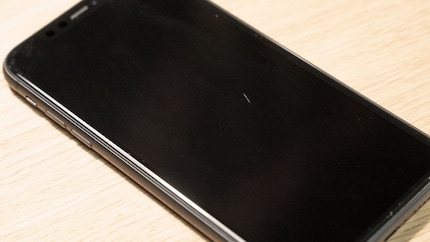
A scratch. In the middle of the display.
No idea how it got there. All I know is that I was carrying the smartphone in my left trouser pocket during my iPhone 11 test. Without any other objects. Nevertheless, the scratch is there. For no reason. Jesus Christ. I don't know what has damaged the Gorilla Glass. Dust particles perhaps. But a grain of dust couldn't have caused something that nasty. Not on an 800 francs phone. Not with this oh-so-"tough" and "durable" glass.
I'm taking this personally. I want to prove that Corning's marketing blah-blah is window dressing.
The test begins.
The theory: When two materials collide, the softer material suffers damage. Gorilla Glass 5 - the predecessor to Gorilla Glass 6 - is designed to withstand a fall from a height of 1.6 metres without shattering. Corning has improved the drop resistance of the fifth generation by making the glass softer; it is less brittle and does not shatter when dropped. However, it is more susceptible to scratches, says the manufacturer.
Other Gorilla Glass 6: According to Corning's internal laboratory tests, it is even more robust than Gorilla Glass 5, but just as resistant to scratches thanks to a new chemical composition
An everyday test is needed.
I take items that you or I usually carry in our trousers, handbags and shoulder bags. Things like coins, keys and headphones. Or lighters. Maybe a bit of dust and dirt that accumulates over time. I rub the display with it and see what happens.
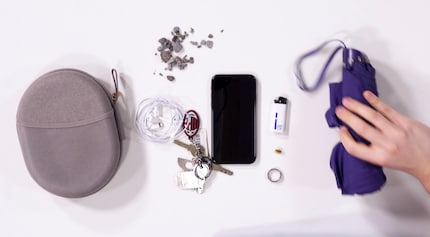
Corning does something similar. This is shown in a video published in 2017, in which the New York-based company puts everyday objects in a mason jar. They add the test phone with Gorilla Glass. The jar is then rotated on its own axis for 45 minutes.
Voilà: the "tumble test".
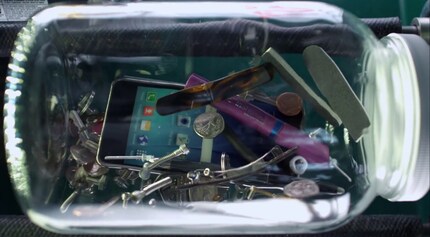
A test lab like Corning's is not available to me. Unlike the glass and ceramics company, I don't have smartphone manufacturers like Apple or Samsung behind me, who invest millions of dollars in research and development of the perfect glass alone. Instead, I rub the objects on the display one after the other. Starting with Apple headphones.
Banging on, scratching around. Rubbing back and forth. Not much happens. A little smear here, a few grease stains there. This can be quickly wiped away with a cleaning cloth. The glass shows no signs of scratching. The vandal in me rejoices. I want more. The nerdy smartphone lover's neck hairs stand on end: should I really carry on?
Okay, next level.
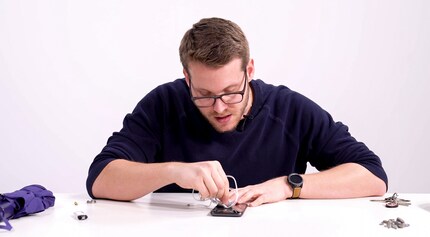
A lighter. More precisely, the jagged flint that produces the flame in combination with the gas. I press the lighter on the display. "Slowly," says the nerdy smartphone lover. "No, harder," the vandal barks back. But there are still no scratches. Not even on the bunch of keys that I rub across the display with all my might next.
I am surprised. If my iPhone 11 testing experience was anything to go by, the display would have been scratched a long time ago. Only when I rub pebbles collected outside with all my might between my palm and the iPhone 11 does the display scratch.

"Oh God," says the smartphone lover.
"Finally," says the vandal.

Interim conclusion: I have to revise my judgement expressed in the iPhone test that the iPhone 11 display scratches much faster than its predecessors, which are equipped with Gorilla Glass 5. Wherever my scratch came from - a simple speck of dust could not have been the cause. Probably not a bunch of keys or a lighter either. More likely a material that is as hard as a pebble.
Did I not protect the iPhone as well as I thought? Hardly. Gorilla Glass 6 can actually withstand a lot. My marketing blah-blah accusations fall flat.
Sorry, Corning. Sorry, Apple.
My new realisation: Corning's new glass is just as scratch-resistant as the old one. Cool. But there's something else I want to test.
Drop resistance.
As a reminder: Corning promises that Gorilla Glass 6 can withstand around 15 drops from a height of 1 metre. I want to replicate that. The decisive factor for a representative test is that I drop the smartphone on roughly similar material to that used by Corning in its laboratory tests.
A video on the test methodology for Gorilla Glass 6 gives me an indication of the surface properties in Corning's drop tests. It talks about a surface that is "rough". So "coarse" or "rough".
That's not precise enough for me.
The Gorilla Glass 5 video published in 2017 gives me more information. It also uses "rough" as an adjective, but adds "unforgiving surfaces like asphalt".
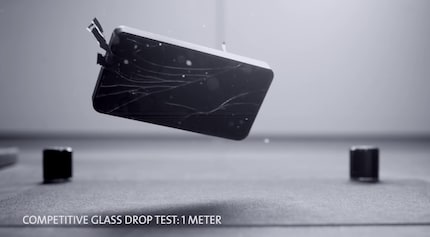
Better. We have a rough stone floor in our studio. It's about as unforgiving as tarmac. I hold out the iPhone 11 and drop it from a height of about one metre.
Clap.
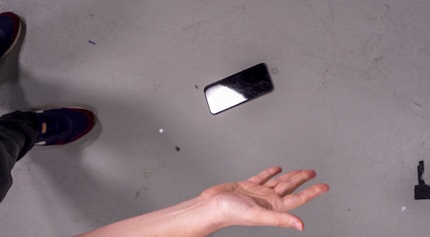
The sound the iPhone makes on impact goes through your bones. The sight of the display too.
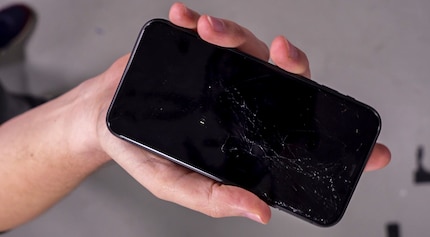
This is not without a certain irony. Corning claims that its competitors' glasses break after just one fall under similar test conditions. In my test, Corning is not a bit better.
14 more drops later, it even looks like this:

No, Corning, the glass can't withstand 15 drops without being damaged. Not for me. Agreed: The display had scratches - scratches, not cracks - which may have already affected the stability of the glass. This is supported by the fact that the glass has more or less splintered along the old scratches. So that would mean that one or two small scratches would be enough to invalidate Corning's 15-fall-without-damage guarantee.
I want to know for sure. So I ask Corning about it.
Corning's answer is not long in coming.
We can confirm that Corning has supplied Apple with glass for the iPhone since the product introduction in 2007 and is included on the latest iPhone device lineup. Further questions on their products should be directed to Apple.
According to this, Gorilla Glass has been installed in all Apple iPhones since 2007. According to Corning, however, all further questions on the topic should be directed to Apple.
I will do that. Apple's response:
No comment.
The no-comment response is hardly surprising. After all, it's not Apple that claims that its smartphones can withstand 15 drops without damage. The Californians are deliberately vague on the topic, speaking only of the "toughest glass ever". That's why it's Corning that disappoints me. After all, it's the New Yorkers who are trying to pass the buck to Apple.
Gorilla Glass 6 turned out to be much more robust and scratch-resistant than my previous iPhone 11 experiences had led me to expect. In terms of drop resistance, however, Corning disappointed me. One drop was enough to break the glass. My guess is that the old scratches are the cause. I can't say for sure - neither Corning nor Apple wanted to comment on the topic.
I write about technology as if it were cinema, and about films as if they were real life. Between bits and blockbusters, I’m after stories that move people, not just generate clicks. And yes – sometimes I listen to film scores louder than I probably should.
Interesting facts about products, behind-the-scenes looks at manufacturers and deep-dives on interesting people.
Show all
Background information
by Florian Bodoky

Background information
by Maike Schuldt-Jensen

Background information
by Samuel Buchmann